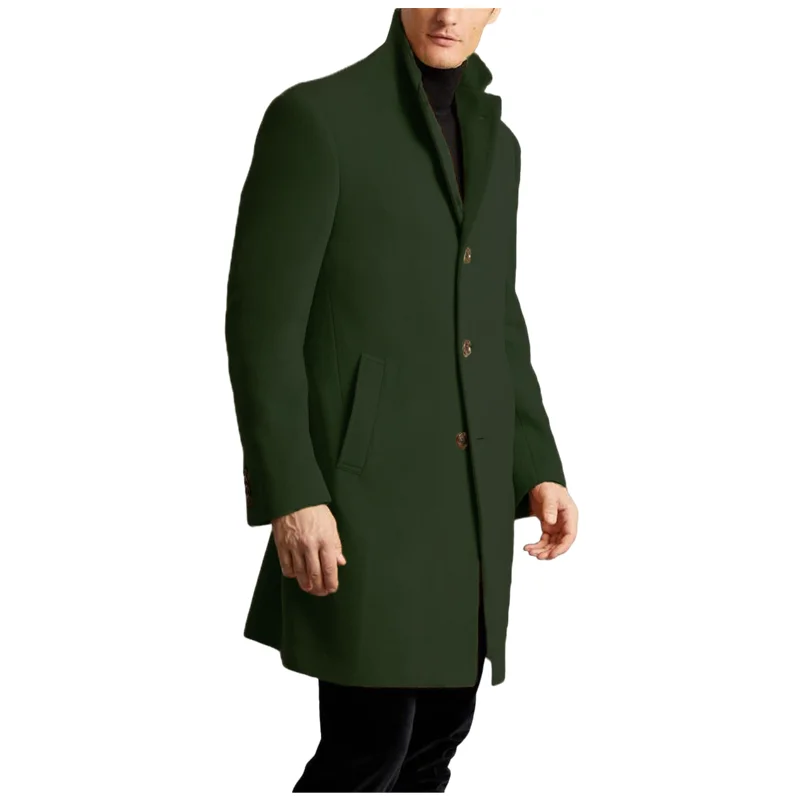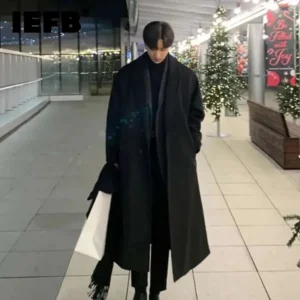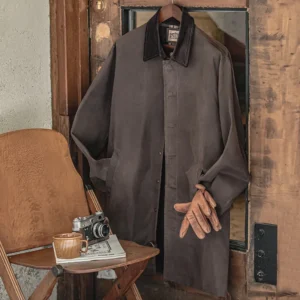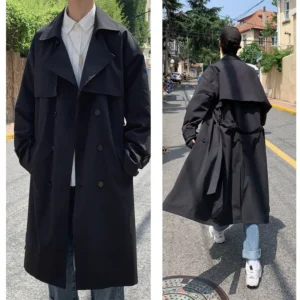Understanding Vintage-Inspired Outerwear: A Primer
In the world of men’s fashion, the term “vintage-inspired” refers to modern garments that deliberately incorporate design elements from past eras. Unlike authentic vintage pieces, which are genuine historical items typically 20+ years old, vintage-inspired coats are new creations that pay homage to classic styles while offering contemporary fit and function.
These coats hold special appeal for the modern man seeking to stand out from the crowd of generic outerwear options. They combine timeless aesthetics with the reliability of new construction, offering unique character without the fragility or sizing limitations often found in true vintage pieces. The hallmark of a quality vintage-inspired coat is its ability to reference historical designs without looking like a costume—creating a bridge between heritage style and modern sensibility.
Understanding the right coat length for your build becomes particularly important when exploring vintage-inspired styles, as proportions play a crucial role in achieving an authentic yet contemporary look. Today’s discerning man appreciates these pieces not just for their distinctive appearance but also for their quality construction and enduring appeal.
Throughout this guide, we’ll explore the specific elements that define vintage-inspired outerwear, helping you identify, appreciate, and confidently wear these distinctive pieces. Whether you’re drawn to the refined elegance of 1930s overcoats or the rugged appeal of mid-century military styles, exploring vintage tweed coat options and other heritage-influenced designs can transform your wardrobe with character and sophistication.
The Key Elements That Define Vintage-Inspired Coats
What transforms a modern coat into something with genuine vintage appeal? The answer lies in a harmonious combination of design elements that work together to evoke a specific era or aesthetic tradition. These components create an authentic vintage feel while maintaining the practicality modern men demand.
At the foundation of any vintage-inspired coat is its silhouette—the overall shape and cut that immediately signals a connection to the past. This framework is then enhanced through deliberate fabric choices that reference traditional materials, from heavyweight wools to distinctive patterns like herringbone or houndstooth. These foundational elements are further refined through carefully selected details and construction techniques that faithfully reproduce the craftsmanship of earlier eras.
The magic happens when these elements are thoughtfully balanced. A truly successful vintage-inspired piece never feels like a costume but rather like a modern interpretation that respects historical precedent. Understanding proper coat length proportions is essential when evaluating these garments, as even subtle variations can dramatically affect how authentic a vintage-inspired coat appears.
The most compelling vintage-inspired coats manage to honor traditional design while incorporating subtle modern improvements in fit, comfort, and functionality—creating pieces that are both timeless and relevant for today’s man.
Silhouettes: The Foundation of Vintage Appeal
The silhouette of a coat—its overall shape, cut, and proportions—is perhaps the most immediate signal of vintage inspiration. These distinctive shapes instantly evoke particular eras and create the foundation upon which all other vintage details build.
The Fitted Mid-Century Profile
The 1940s introduced a more structured, military-influenced silhouette that remains strikingly handsome today. These coats feature defined shoulders, a slightly nipped waist, and a clean drape through the torso. This tailored approach creates a masculine profile that flatters most body types while nodding to the utilitarian elegance of the post-war era.
The Classic Double-Breasted Statement
Few silhouettes command attention like the double-breasted overcoat. Traditional versions feature wider lapels, a 6×2 or 6×3 button arrangement, and a slightly fuller cut through the chest and shoulders. This silhouette speaks of mid-century elegance and projects confidence and sophistication. Our selection of double-breasted overcoats demonstrates how this classic shape can be adapted for the modern man.
The Full Swing Coat
Drawing inspiration from the 1950s-60s, swing coats feature an A-line shape that starts fitted at the shoulders and gradually widens toward the hem. This silhouette offers ease of movement and creates a dramatic profile, particularly in motion. The generous cut allows comfortable layering while maintaining a refined appearance.
The Boxy Oversized Style
Certain vintage-inspired coats reference either early 1920s cuts or 1980s reinterpretations with deliberately oversized, boxy silhouettes. These coats feature dropped shoulders, wider sleeves, and a straight cut through the body. When executed properly, this relaxed silhouette balances casual comfort with intentional style rather than appearing simply ill-fitting.
The length of a vintage-inspired coat also significantly influences its overall impression and historical reference point. From knee-length chesterfields to calf-grazing greatcoats, each variation carries specific connotations and styling possibilities.
Classic Materials: Fabrics That Speak to Heritage
The materials used in a vintage-inspired coat do more than just provide warmth—they establish authenticity through texture, weight, and visual character that modern mass-market fabrics often lack.
Premium Wools: Traditional wool varieties form the cornerstone of heritage-inspired outerwear. Herringbone patterns with their distinctive V-shaped weave instantly signal vintage quality, while robust tweeds with their characteristic flecks of color speak of British heritage. Dense melton wool offers structure and weather resistance that has served men well for generations.
Gabardine and Mackintosh Cloth: These tightly woven fabrics have provided weather protection since the late 19th century. Their smooth finish and natural water resistance make them perfect for trench coats and rainwear with vintage appeal without sacrificing practical performance.
Luxury Natural Fibers: Camel hair coats with their distinctive color and remarkable insulation properties remain icons of refinement. Similarly, cashmere overcoats represent the pinnacle of luxury outerwear, offering incomparable softness and warmth that has been valued for centuries.
Textured Casual Fabrics: Corduroy with its distinctive ridged surface and sturdy moleskin offer casual vintage character perfect for less formal outerwear styles. These materials bring tactile interest and durability to country-inspired and workwear-influenced designs.
Fabric weight also plays a crucial role in vintage authenticity. Modern manufacturing often prioritizes lightness, but truly traditional herringbone coats feature substantial fabrics that drape beautifully and provide genuine warmth. This heavier hand feels significant and substantial—a quality increasingly rare in contemporary fashion.
The patterns woven into these fabrics—subtle checks, windowpanes, and textured weaves—further enhance vintage character while adding visual depth that elevates the entire garment.

Distinctive Details: The Hallmarks of Vintage Design
What truly separates an ordinary coat from one with authentic vintage character often comes down to thoughtful details—those smaller elements that reveal a garment’s heritage inspiration and commitment to traditional design language.
Collar and Lapel Treatments
The face-framing elements of a coat make an immediate impression and strongly reference particular eras:
- Wide, peaked lapels suggest 1930s-40s elegance
- Notched lapels with generous width recall mid-century sophistication
- Ulster collars with their characteristic fold-over design provide both practicality and traditional British character
- Throat latches—small tabs that button across the neck—offer weather protection and distinctive visual detail
- Convertible collars that can be worn up or down provide versatility with vintage utility
Shoulder Construction
How a coat’s shoulder is structured significantly influences its silhouette and period feel:
- Natural shoulders with minimal padding create a relaxed, draping effect seen in certain 1920s and 1950s designs
- Structured shoulders with defined shape reference military influence and mid-century formality
- Raglan sleeves that extend to the collar rather than the shoulder seam offer a distinctive silhouette particularly associated with certain overcoat styles
Pocket Designs
Pocket styling offers subtle but meaningful vintage cues:
- Patch pockets—sewn to the coat’s exterior—bring casual character to formal silhouettes
- Flap pockets provide protection and structure
- The ticket pocket—a smaller additional pocket above the right main pocket—is a quintessential detail from traditional British tailoring
- Internal pockets with piping, button closures, or distinctive shapes reflect an era when garment interiors received as much attention as exteriors
Button and Closure Elements
The way a coat fastens contains rich historical references:
- Horn buttons in varying sizes and colors add natural texture and subtle luxury
- Metal buttons, particularly brass or pewter, reference military heritage
- Leather buttons bring country influences to city coats
- Toggle closures, originally designed for naval duffle coats, offer distinctive character
- Hidden plackets that conceal the buttons create a clean, refined appearance
These details can be explored extensively in our collection of classic wool overcoats, where traditional elements are preserved and celebrated rather than simplified for mass production.
Craftsmanship: Construction Techniques With Heritage
Beyond visible design elements, the construction methods used in vintage-inspired coats significantly influence their quality, appearance, and longevity. These techniques represent continuing traditions of craftsmanship that have largely disappeared from mainstream fashion.
The hallmarks of heritage construction include:
- Hand-Finished Elements
- Pick stitching along lapels and pockets provides visual texture and strength
- Hand-sewn buttonholes that flex and move naturally with wear
Hand-attached linings that allow natural movement between shell and interior
Canvas Construction
- Full canvas—a structured layer between shell and lining throughout the coat
- Half-canvas construction that provides structure through the chest and shoulders
The floating canvas that allows the coat to mold to the wearer’s body over time
Reinforcement Techniques
- Bar tacks at pocket corners prevent tearing under stress
- Reinforced seams at natural stress points ensure durability
Interior tape along seams prevents stretching over years of wear
Interior Finishing
- Properly constructed sleeve linings that allow ease of movement
- Interior pockets with functional closures and reinforcement
- Clean seam finishing that prevents fraying even after extensive wear
While modern manufacturing has developed more efficient methods, these traditional techniques create garments with superior drape, comfort that improves with age, and the ability to be repaired rather than replaced—all qualities that align with the sustainability concerns of today’s conscious consumer.
Understanding how to style heritage garments becomes easier when you appreciate the craftsmanship that went into their creation, allowing you to recognize quality that will maintain its appearance and function for years to come.
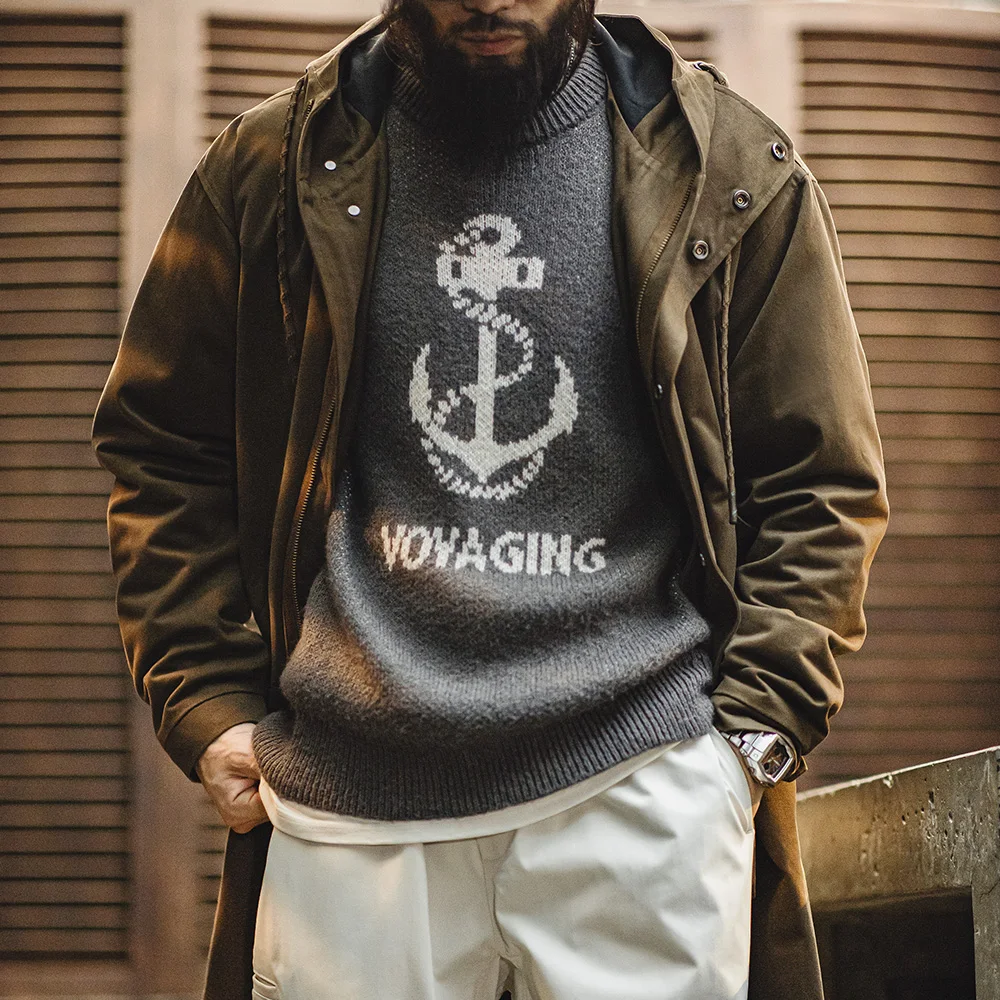
Historical Influences: Iconic Eras in Men’s Outerwear
The vintage-inspired coats available today draw from rich historical traditions, each era contributing distinctive design elements that continue to influence modern menswear.
1920s-1930s: The Golden Age of Elegance
The interwar period established many enduring classics in men’s outerwear. This era introduced:
- Elegant polo coats in their characteristic camel color, featuring loose, draped silhouettes
- The refined chesterfield overcoat with its velvet collar and clean lines
- Art Deco influence seen in geometric patterns and decorative details
- The beginning of the modern camel coat tradition, prized for its distinctive color and insulating properties
These designs emphasized graceful drape and luxurious materials, reflecting the cosmopolitan sophistication of the age.
1940s-1950s: Utility and Refinement
World War II and its aftermath profoundly shaped men’s outerwear, introducing:
- Military-inspired greatcoats with their commanding presence and practical details
- The refinement of the trench coat from military gear to civilian essential
- Structured shoulders and tailored waists that created a distinctly masculine silhouette
- Functional elements like storm flaps, epaulets, and D-rings that served practical purposes in their original context
Post-war prosperity allowed these utilitarian designs to be adapted for civilian life, combining functionality with increasing refinement.
1960s-1970s: Experimentation and Expression
This period of social change brought fresh approaches to traditional outerwear:
- More relaxed interpretations of formal coats, with softer construction and varied lengths
- Experimentation with proportion, including both extremely fitted and deliberately oversized silhouettes
- Integration of casual elements into previously formal coat categories
- New fabric treatments and pattern applications that broke with tradition while referencing it
The enduring appeal of traditional tweed coats demonstrates how these historical influences continue to resonate with modern men seeking substance and character in their wardrobe choices.
Mens Black Overcoat, Mens Black Wool Coat, Mens Wool Overcoat
$339.18 Select options This product has multiple variants. The options may be chosen on the product pageMens Grey Overcoat, Mens Wool Blend Coat, Mens Wool Overcoat
$201.28 Select options This product has multiple variants. The options may be chosen on the product pageMens Herringbone Coat, Mens Long Overcoat, Mens Wool Overcoat
Price range: $197.16 through $203.69 Select options This product has multiple variants. The options may be chosen on the product pageMens Long Overcoat, Mens Tweed Coat
Price range: $397.49 through $409.96 Select options This product has multiple variants. The options may be chosen on the product pageMens Shearling Coat, Mens Sheepskin Coat
$888.08 Select options This product has multiple variants. The options may be chosen on the product pageMens Double Breasted Overcoat, Mens Long Overcoat
Price range: $181.32 through $198.08 Select options This product has multiple variants. The options may be chosen on the product page
How to Recognize Quality in Vintage-Inspired Coats
Identifying truly exceptional vintage-inspired outerwear requires attention to specific indicators of quality that distinguish investment pieces from mere fashion items.
Material Assessment
Begin your evaluation with the fabric itself:
- Run your hand across the material—quality wool should feel substantial but soft, with a dense hand that suggests durability
- Check natural fiber content (wool, cashmere, camel hair) rather than synthetic-heavy blends that lack the drape and insulation of traditional materials
- Examine the color for depth and richness—quality fabrics show subtle variations rather than flat, uniform color
- Test the drape by holding the fabric up—it should fall in a smooth, graceful manner appropriate to its weight
Construction Evaluation
Quality construction reveals itself through careful examination:
- Check seams for even, tight stitching with no puckering or gaps
- Examine button attachment—quality buttons are securely sewn with reinforcement or shanks that create proper spacing
- Inspect the lining to ensure it’s properly attached but allows movement without pulling or stretching the outer fabric
- Look for pattern matching at seams, particularly in plaid or striped fabrics
Design Coherence
A thoughtfully designed vintage-inspired coat maintains:
- Proportionally balanced elements appropriate to the style (lapel width should harmonize with shoulder width, for instance)
- Historically accurate details used with purpose rather than randomly applied
- Thoughtful updates to vintage elements that improve function without compromising aesthetic integrity
Understanding coat proportions for your height helps evaluate whether a vintage-inspired piece will flatter your specific build while maintaining authentic design integrity.
When evaluating short versus long coat styles, remember that proper proportion is essential to achieving the intended vintage effect without looking costume-like or dated.
Styling Vintage-Inspired Outerwear for Today’s Man
Incorporating vintage-inspired coats into a contemporary wardrobe requires thoughtful balance between honoring historical references and maintaining modern relevance.
For Business and Formal Occasions
- Pair a structured vintage-inspired overcoat with modern tailoring in complementary proportions
- Choose subtle vintage elements rather than combining multiple bold historical references
- Keep accessories refined and proportional—a cashmere scarf and leather gloves in clean designs complement rather than compete with your coat
- Consider how the coat’s silhouette works with your suit—fuller coats generally require more structured suiting, while fitted coats offer more versatility
For Smart Casual Settings
- Balance a distinctive vintage coat with simple, modern foundational pieces
- Combine a herringbone or tweed overcoat with dark denim and a solid sweater
- Let the coat be the focal point by keeping other elements in your outfit more understated
- Consider texture mixing—a textured vintage-inspired coat pairs beautifully with knits of varying weights
For Weekend and Casual Wear
- More casual vintage-inspired pieces like shearling jackets or corduroy coats pair naturally with rugged weekend wear
- Combine heritage outerwear with modern technical layers for practical cold-weather style
- Don’t fear mixing eras—a 1960s-inspired coat can work wonderfully with contemporary casual pieces
Proper accessorizing enhances the impact of vintage-inspired outerwear:
- Hats should complement rather than mimic the coat’s era—a simple beanie or minimalist fedora avoids costumey combinations
- Scarves offer opportunities to introduce complementary colors and textures
- Footwear should balance the coat’s formality—sleek boots or clean sneakers often work better than highly decorative shoes that compete for attention
The shearling coat styles in our collection demonstrate how heritage designs can be adapted for the modern man’s lifestyle without losing their distinctive character.
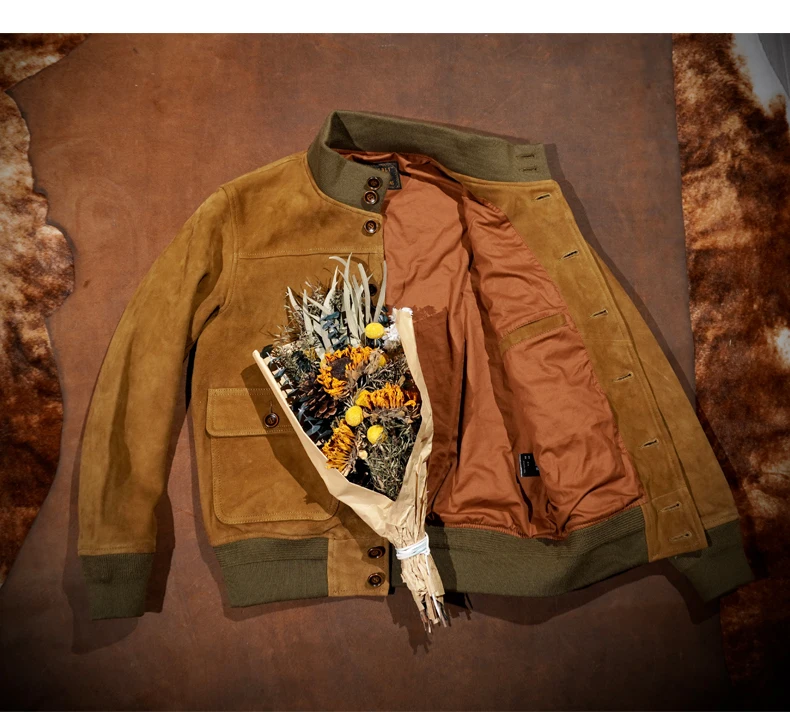
Is Vintage-Inspired Right for Every Man?
Many men hesitate before investing in vintage-inspired outerwear, questioning whether these distinctive styles will suit their personal aesthetic or practical needs. The beauty of vintage-inspired design lies in its remarkable adaptability across different personal styles and body types.
For those with a classic personal style, vintage-inspired coats offer a natural extension of that aesthetic. However, even men who favor contemporary fashion find that a well-chosen vintage-inspired piece adds character and sophistication to otherwise modern ensembles.
Different body types can indeed benefit from various vintage silhouettes. Taller men often look commanding in longer overcoats with substantial details, while shorter men might find three-quarter length coats with clean lines more flattering. Fuller figures generally benefit from structured shoulders and clean drape, while slimmer builds can carry both fitted and more voluminous styles effectively.
The investment value of quality vintage-inspired pieces cannot be overstated. Unlike trend-driven items that quickly look dated, these coats reference designs that have already proven their longevity over decades—making them remarkably resistant to the fickle cycles of fashion.
Can Vintage-Inspired Coats Be Practical for Modern Lifestyles?
Yes, today’s vintage-inspired coats successfully combine historical aesthetics with practical function for contemporary life. Modern manufacturing has addressed many historical limitations while preserving authentic character.
Many vintage-inspired pieces now incorporate discreet technical elements like water-resistant treatments on wool or windproof membranes between layers. These improvements enhance performance without compromising appearance. Similarly, modern sizing standards and subtle adjustments to traditional patterns create more comfortable fit for today’s more casual lifestyle and varied body types.
Care requirements for quality vintage-inspired outerwear are straightforward but differ from mass-market alternatives. Most benefit from occasional professional cleaning rather than frequent washing, and proper hanging on shaped hangers helps maintain their structured silhouettes. With minimal care, these garments will significantly outlast cheaper alternatives.
Climate versatility has also been addressed in contemporary vintage-inspired designs. Manufacturers like Metro Cloak now offer traditional styles adapted for various weather conditions, from lightweight transitional coats to heavily insulated winter options—all while maintaining authentic design language.
How Do Vintage-Inspired Coats Compare to Fast Fashion Alternatives?
The contrast between quality vintage-inspired outerwear and mass-market alternatives becomes evident in several key areas:
In terms of longevity, well-made vintage-inspired coats commonly remain serviceable and stylish for decades rather than seasons. This extended lifespan dramatically affects their true cost—while the initial investment might be 3-5 times higher than fast fashion alternatives, the cost-per-wear often proves significantly lower when amortized over years of use.
The construction quality directly impacts this durability. Where fast fashion prioritizes rapid production and minimum materials, heritage-inspired pieces feature reinforced stress points, quality closures, and materials selected for performance over time rather than initial appearance alone.
The environmental impact differs substantially as well. The “slow fashion” approach of quality vintage-inspired pieces—buying fewer, better items—reduces the resource consumption and waste generation associated with frequently replaced garments.
Perhaps most importantly, vintage-inspired coats offer distinctive character increasingly rare in standardized mass fashion. The subtle details, quality materials, and thoughtful proportions create a sophisticated impression that generic alternatives simply cannot match.
What Are Common Misconceptions About Vintage-Inspired Outerwear?
Several persistent myths prevent some men from exploring vintage-inspired outerwear, despite its potential to elevate their wardrobe.
Myth: Vintage-inspired coats are uncomfortable or restrictive.
Reality: Quality vintage-inspired designs actually prioritize movement and comfort through thoughtful construction. Features like center vents, proper sleeve pitch, and floating canvas create garments that move naturally with the body.
Myth: These coats look costume-like or overly dramatic.
Reality: Sophisticated vintage-inspired pieces incorporate historical elements with restraint. They reference tradition without literal reproduction, creating distinctive but wearable garments appropriate for contemporary life.
Myth: Heritage styles only work for formal occasions.
Reality: Vintage-inspired outerwear spans the full spectrum from highly structured formal overcoats to relaxed casual pieces. The breadth of historical reference points means there are suitable options for virtually any dress code or lifestyle.
Myth: These coats require complicated maintenance.
Reality: While quality outerwear benefits from appropriate care, the requirements are rarely onerous. The substantial materials used in vintage-inspired coats often actually require less frequent cleaning and prove more forgiving than their lighter-weight counterparts.
By understanding the true nature of well-designed vintage-inspired outerwear, today’s man can make informed choices about incorporating these distinctive, characterful pieces into his wardrobe.

